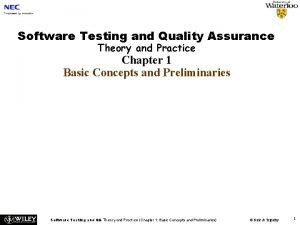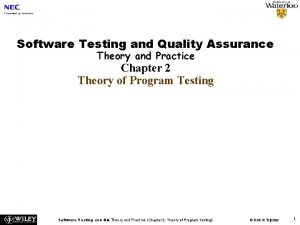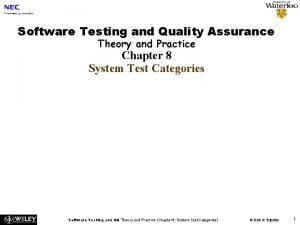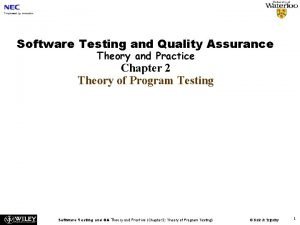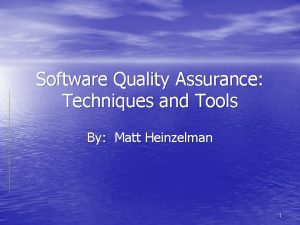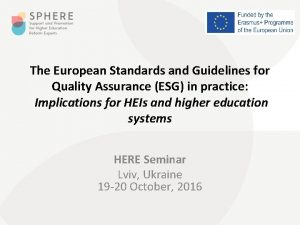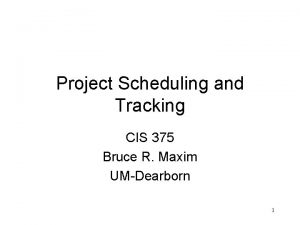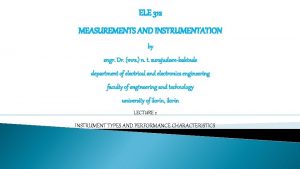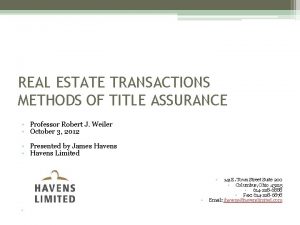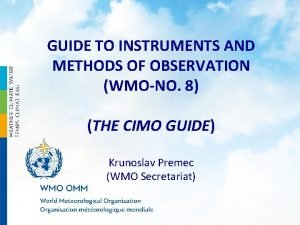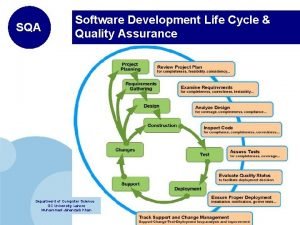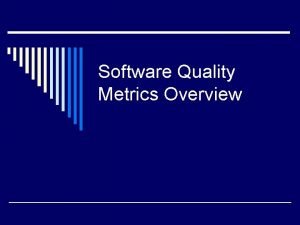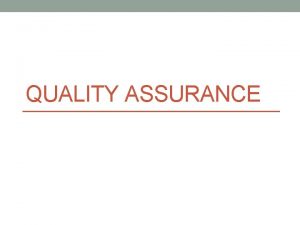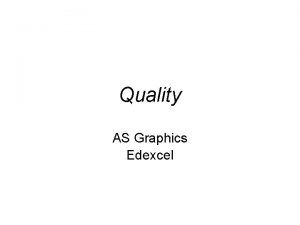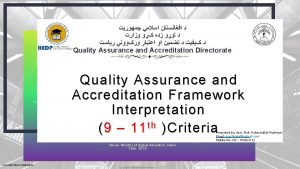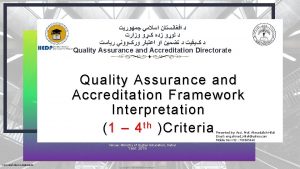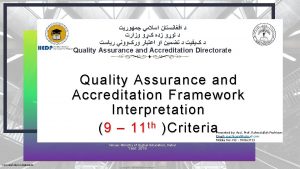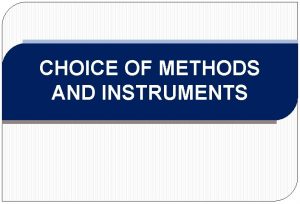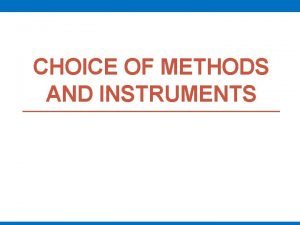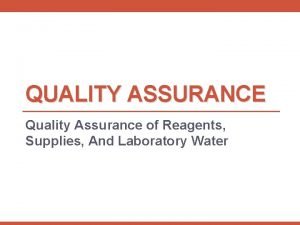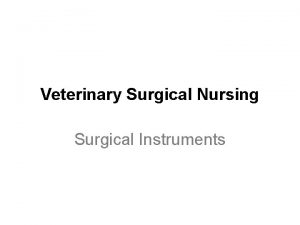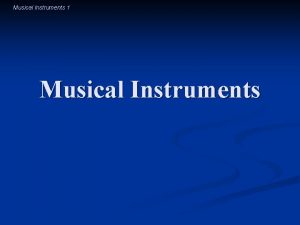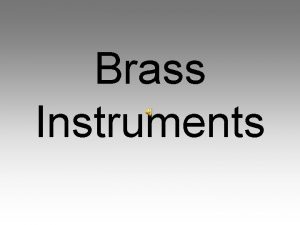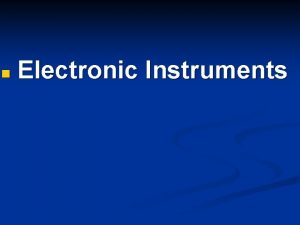QUALITY ASSURANCE Choice of Methods and Instruments Choice




















- Slides: 20

QUALITY ASSURANCE Choice of Methods and Instruments

• Choice of proper instrument or method of analysis is a major preventive quality assurance activity that will affect the quality of the service provided • The process of choosing a new instrument or kit can be divided into two parts: • Method selection • Method evaluation 2

A good quality assurance program has three major aspects: 3

Method Selection • The goal of the selection process is to choose a test method that best suits the laboratory's service requirements • The primary consideration for making this selection should be based on the test method's usefulness in providing medically relevant data • The demands on the laboratory are imposed by the users of its services and this information can be determined by communicating with these users • In making the selection among various methods, the desired characteristics should be carefully considered 4

Method Selection • Three classes of characteristics should be considered: 1 - The method's application characteristics: • These are the characteristics of a test method that determine whether it can or cannot be implemented in a particular laboratory, include factors such as: • cost per test • types • turnaround time of specimens • rate of analysis • sample volume • run • personnel • space and utility requirements size, materials • safety considerations 5

Method Selection 2 - Methodology characteristics: • Include conditions that are method-specific and contribute to the quality of the method such as: • Chemical sensitivity and specificity, • manner of calibration, • and optimization of the reaction 3 - Performance characteristics: • Those that determine how well the method performs in its practical application. They include: • the method's linear range (also known as the analytical or working range), • its precision, • and its accuracy 6

Method Selection- Sources of Information • You need to have a full information before deciding to buy a new instrument or kit • The best sources of information are: • The laboratory technical literature (Journals) • it will have evaluations and testimonials for different methods and instruments • Use the literature to find the method's application, methodology, and performance characteristics • Conferences & Exhibitions • Vendors come to show their wares with demonstrations and discussions • Word-of-mouth recommendations • From reliable and trustworthy sources 7

Method Evaluation • Once an instrument or test kit has been selected as a possible candidate for use, evaluate it carefully before making a final commitment • The evaluation process should be logically structured so that a minimum of time and effort need be invested to obtain maximum results • Goals of the evaluation includes: • Determination of the accuracy and precision of the method • To evaluate the magnitude of the method's inherent random and systematic error • Discover if the new method fits into the framework of the laboratory's organization and workload 8

Method Evaluation • The evaluation should last for no less than one week and no more than 60 days • It is recommended to be a minimum of 20 days for a complete evaluation that includes day-to-day precision studies • Enough time should be allowed to perform all of the necessary evaluation experiments and to observe the instrument's day-to-day variation • Too short a time period may result in important data being missed or misrepresented • Too long an evaluation period may last longer than the expiration date of reagents, calibrators, and controls, and also incorporate long-range instrument variation 9

Method Evaluation- Linearity Check • The first step in the Evaluation process is to perform a Linearity Check • Standard of high conc. can be diluted to obtain a series of samples of known conc. • Range should cover both ends of the method’s range of linearity • Analyze the sample and compare the results to the expected values by constructing a scatter plot • Place the expected value on the ordinate(x-axis) and the obtained value on the abscissa (y-axis) and draw a line of agreement 10

Method Evaluation- Linearity Check • Analyze each sample in triplicate and average the results • Accept the method's linearity if the line of agreement has a slope of 1. 000 ± 0. 03 and an intercept of zero plus or minus the within-run precision of the method • Investigate pipetting errors as the probable cause of a nonlinear line by repeating the experiment with a freshly diluted series of samples 11

12

Method Evaluation- Replication Experiment • This evaluation experiment is used to demonstrate a test method's precision and random error • Three different replication studies are performed: • within-run, • within-day, • and day-to-day • Choose three samples that have the same matrix or physical qualities as the patient samples that the method will be analyzing • The three should represent the low, normal, and high physiological concentrations of the analyte in question 13

Method Evaluation- Replication Experiment • The within-run replication experiment measures precision or the lack of it caused by random error within an analytical run • Each sample is analyzed a minimum of 20 times within a single analytical run • The within-day replication experiment measures the amount of random error between runs that occurs within a single day • Each of the three samples is analyzed a minimum of 20 times throughout the day in several analytical runs • The day-to-day replication experiment measures the amount of random error inherent in the method from dayto-day • Analyze each sample daily for a minimum of 20 consecutive days 14

Method Evaluation- Replication Experiment • For each of the replication experiments, calculate a mean, mode, standard deviation (s), and coefficient of variation (CV) for each sample • The greater the imprecision of the method, the larger the standard deviation will be • It will be a greater percentage of the mean or will have a greater CV • If the distribution of the values is due to random chance, then it should have a normal or Gaussian distribution 15

Method Evaluation- Recovery Experiment • The recovery experiment is performed to estimate the proportional systematic error in the absence of a reliable comparative or reference method • This is the type of error whose magnitude increases as the concentration of analyte increases • The error is often caused by a substance in the sample matrix that reacts with the sought for analyte and therefore competes with the analytical reagent 16

Method Evaluation- Interference Experiment • The interference experiment is performed to estimate the systematic error caused by other materials that may be present in the specimen being analyzed • We describe these errors as constant systematic errors because a given concentration of interfering material will generally cause a constant amount of error regardless of the concentration of the analyte being tested in the specimen • As the concentration of interfering material changes, however, the size of the error is expected to change 17

• Experiments and type of error which can be detected 18

Method Evaluation- Comparison of Methods • One of the easiest methods is to plot the results on a scattergram • Draw the best straight line through the points and determine the slope and intercept of the line • The slope and intercept offer a fair evaluation of the agreement between the methods 19

Comparison Of Methods Perfect correlation (Hypothetical) Slope (b) = 1 Y intercept (a) = 0 Correlation coefficent (r) = 1 20
 Quality assurance instruments
Quality assurance instruments Quality control and quality assurance
Quality control and quality assurance Concept of quality assurance
Concept of quality assurance Pmp quality management
Pmp quality management Pmp gold plating
Pmp gold plating Process of nursing audit
Process of nursing audit Compliance vs quality
Compliance vs quality Quality assurance theory
Quality assurance theory Quality revolution
Quality revolution Software testing and quality assurance theory and practice
Software testing and quality assurance theory and practice Software testing and quality assurance theory and practice
Software testing and quality assurance theory and practice Quality assurance theory
Quality assurance theory Sqa tools and techniques
Sqa tools and techniques European standards and guidelines for quality assurance
European standards and guidelines for quality assurance Compartmentalization interdependency effort validation r
Compartmentalization interdependency effort validation r Example of null type instrument
Example of null type instrument Indicating instruments and instruments with a signal output
Indicating instruments and instruments with a signal output Methods of title assurance
Methods of title assurance Cimo guide
Cimo guide Sdlc quality assurance
Sdlc quality assurance Types of software metrics
Types of software metrics








